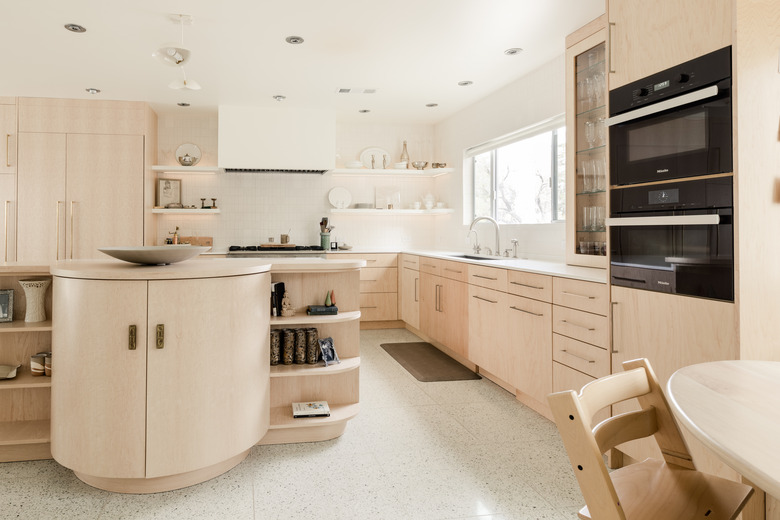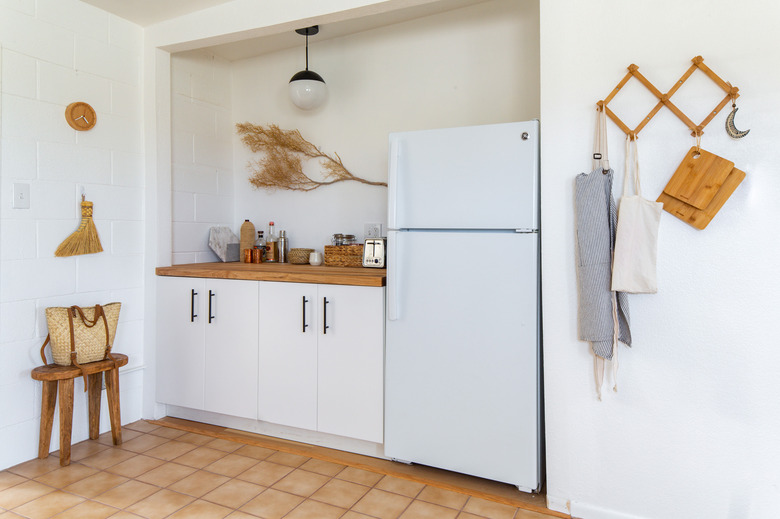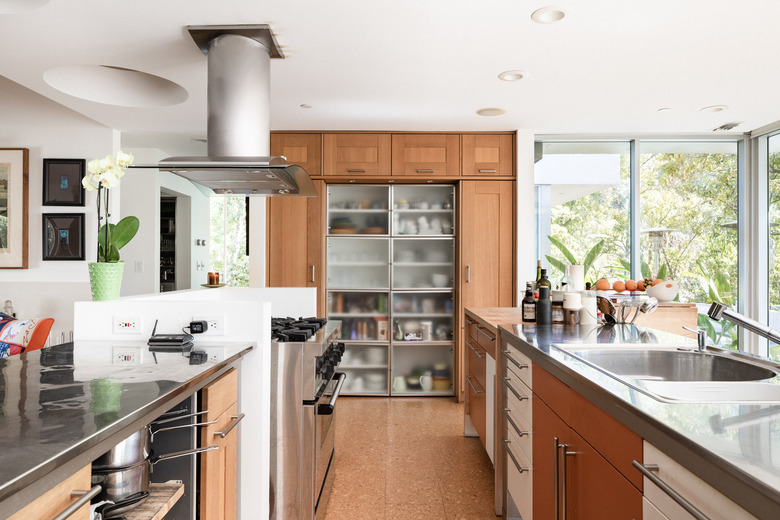Kitchen Flooring Buying Guide
Many flooring options are available to you if you are remodeling or building your kitchen. No single kitchen floor material is perfect for all situations; the choice is a balancing act between ease of installation, durability, maintenance and price. Referring to a buying guide is a good way to compare popular flooring options such as tile, luxury vinyl planks, linoleum, sheet vinyl and cork.
How to Pick the Right Floor for Your Kitchen
How to Pick the Right Floor for Your Kitchen
Kitchens are favored places in most homes. Not only do we cook and eat there but we also socialize with friends, catch up with family and do household business. Since the kitchen is the hub of the home, it deserves the best floor possible.
Kitchen flooring is expected to do so much: be sturdy, protect against moisture, remain economical and above all, be attractive. Breaking down the decision-making process into discrete topics allows you to prioritize the qualities that mean the most to you.
Who will install your kitchen floor? If you would like technicians to install the flooring, then ease of installation is less of a concern since these are paid professionals who do this on a near-daily basis. However, for the do-it-yourselfer, ease of installation is crucial. Beginning DIYers will find floating floors easier to install than floors that must be attached to the subfloor or to the underlayment.
Durability and resistance to wear and tear is important, too. While you might expect to occasionally repaint a bedroom or change a ceiling light, a kitchen floor will remain in place for years — if not decades — since flooring cannot be easily changed. During this time, you expect the floor to retain its good looks and continue to function well.
After the kitchen floor has been installed, you will need to maintain it. Floors that are easier to maintain get cleaned more often. Flat, seamless floors are simple to sweep and mop. Organic materials such as wood and cork may begin to degrade in high-moisture areas, such as near the kitchen sink or dishwasher.
In the end, price determines the flooring options you will consider. Calculate your kitchen flooring budget by measuring length by width to obtain the area in square footage. Side areas should be added to the total. Add another 10 percent to 15 percent to account for overage, or necessary waste material. Kitchen flooring can begin just below $1 per square foot for tile and sheet vinyl. Luxury vinyl flooring, cork flooring and linoleum generally cost between $2 and $7 per square foot.
Ceramic and Porcelain Tile
Ceramic and Porcelain Tile
Ceramic and porcelain tile have long had a place on kitchen floors. With a history stretching back several millennia, tile has proved its worth as a hard, durable flooring material. Ceramic and porcelain tile classifications differ in terms of water absorption rate. Porcelain tile has a water absorption rate of 0.5 percent or lower, as defined by the Porcelain Tile Certification Agency.
Homeowners inexperienced at tile setting may find it difficult to lay tile in a large space such as a kitchen. With some practice, a homeowner can learn to skillfully install ceramic or porcelain tile. It helps to begin with a smaller space, such as a powder room or mud room, before graduating to the larger, more visible space of the kitchen floor.
Ceramic and porcelain tile are highly durable. Quality tile repels surface scratches, making tile ideal for a home with pets or active children. Heavy objects dropped on tile, such as small appliances or wine bottles can crack the tile. Nonslip mats placed in front of the countertop can help protect the tile. As an added benefit, since tile is hard on your feet when standing for long periods, mats add some comfort.
Tile is easy to sweep and mop. You can wet mop tile with no fear of ruining the tile or subfloor with excess water. Rectified edge, or square-cut, tiles' tight 1/8-inch to 1/16-inch joints are the easiest to clean of all. Wide grout joints of 3/8 inch or greater make cleaning more difficult.
Prices for ceramic and porcelain tile spread as far as from $1 per square foot for in-stock production tile to $20 and more per square foot for artisan tile.
Luxury Vinyl Plank Flooring
Luxury Vinyl Plank Flooring
Luxury vinyl plank flooring provides homeowners with the rare opportunity to have the look of wood in their kitchens with the maintenance advantages of vinyl flooring. With deep embossing and crisp graphics, luxury vinyl plank flooring looks like real wood flooring at only a fraction of the cost.
As a floating floor, luxury vinyl plank flooring is one of the easiest types of flooring materials to install. With floating floors, planks join side to side, much like tongue-and-groove solid wood or engineered wood flooring. Since the boards attach only to each other, there is no need to attach them to the underlayment or subfloor.
This installation advantage aligns luxury vinyl flooring with its closest contender: laminate flooring. When the base of laminate flooring is in contact with water for too long, it can swell and begin to delaminate. Yet unlike laminate flooring, luxury vinyl flooring is 100-percent waterproof. It can be immersed in water for long periods and retain its structure.
Luxury vinyl flooring is highly durable and easy to maintain, and some manufacturers warrant their vinyl products for 20 years or more. Smooth surfaces allow for easier sweeping, and as long as the planks are tightly joined, wet mopping is allowed.
On a materials-only basis, luxury vinyl flooring costs between $2 and $5 per square foot. Thicker, solid-core luxury vinyl flooring with deeper embossing and more realistic graphics may run over $7 per square foot.
Linoleum Tile Flooring
Linoleum Tile Flooring
Until it was supplanted by vinyl flooring, linoleum reigned as the favored kitchen flooring material for much of the 20th century. Many older homes still have linoleum flooring in good condition. With greater attention paid toward green, eco-friendly building materials, linoleum has seen an upswing in popularity.
Linoleum is composed of 97-percent natural raw materials, with much of that content being recycled. About 70 percent of those materials renew rapidly., such as linseed oil, waste wood flour and jute fibers, which provide the basis for linoleum.
Newer iterations of linoleum are even greener than before. In fact, today's linoleum is fully biodegradable. After the linoleum has reached the end of its life span, the flooring can be composted with other organic materials or safely incinerated.
Linoleum tile flooring is extremely durable, with some brands projecting up to a 40-year lifespan. Linoleum is impervious to water: Linoleum in the cabins of the Titanic ship is still intact and in good shape despite being immersed for over a century.
Linoleum flooring is low maintenance, even for high traffic areas. Damage from foot and paw traffic is largely warded off by linoleum's super-tough, dense composition. If feet and paws end up doing damage to the linoleum, this damage, if minor, can be buffed out with the correct equipment. With its smooth surface and minimal seaming, linoleum flooring is simple to clean with a dry broom or a wet mop.
Since linoleum tile today is mainly associated with vintage or higher-end home remodels, expect stylish designs that take your kitchen beyond the ordinary. Much of today's linoleum tile is created in small design studios that draw inspiration from architecture, art, urban landscapes and nature. All linoleum tile has a matte finish, so even bold colors have a softer, pastel appearance.
Glue-down linoleum tile costs from $4 to $6 per square foot. Figure in the added costs of tile adhesive and the purchase or rental of a flooring roller.
Sheet Vinyl Flooring
Sheet Vinyl Flooring
Sheet vinyl combines the moisture-shedding qualities of resilient flooring with another important quality shared by few other flooring materials: no or few seams. With other flooring, moisture can find its way through by penetrating the surface or seeping through seams between sheets or planks. Sheet vinyl's surface is impervious to water.
For kitchen floors that are narrower than 12 feet, sheet vinyl can be laid in one continuous, seamless strip. If the floor is wider than 12 feet, the sheet vinyl may receive one or more seams.
Installation of sheet vinyl flooring is generally best left to the hands of qualified technicians. Rolls are heavy and difficult to handle. Creating cut-outs in large, single sheets can be challenging. Smooth underlayment should be installed over old irregular flooring or subflooring to prevent imperfections in the lower surface from transmitting to the thin, flexible vinyl.
When installing vinyl flooring planks, you can create a configuration of planks to avoid repetition. With sheet vinyl flooring, though, the visual appearance of individual planks or tiles is preset, as it is stamped into the sheets with large presses at the factory. This means that sheet vinyl offers fewer styles than plank or tile vinyl flooring. The upside is that installing large sheets is quicker since it is not necessary to mix and match potentially hundreds of individual flooring planks or tiles.
The industry term for vinyl flooring, including sheet vinyl flooring, is "resilient flooring." This is a signal to potential buyers that vinyl flooring is keyed into durability and resistance to wear and tear. Sheet vinyl's minimal seams mean that it is simple to sweep away debris. Most newer sheet vinyl floor materials have a protective finish that repels dirt and stains.
Sheet vinyl flooring can be quite inexpensive on a materials-only basis, with some name-brand sheet vinyl products even starting below $1 per square foot. However, since sheet vinyl flooring is usually professionally installed, factor in the cost of labor as well as additional materials such as adhesive.
Cork Tile Flooring
Cork Tile Flooring
Cork flooring has emerged recently as a smart flooring option for eco-conscious homeowners who also want superior performance. Not only is cork flooring produced entirely from renewable resources but it is also comfortable, warm and quiet. Cork flooring's elastic composition helps the feet, ankles and legs while the user stands at the sink and counter for long periods.
Cork flooring tiles can be installed on a floating basis with boards attaching side to side. Cork flooring is soft enough to cut with a hand saw. Some cork tiles can even be scored and snapped with a utility knife and metal straightedge tool. Cork flooring does not require a foam or felt underlayment, but it does need a 6-mil poly vapor barrier for moisture protection.
Cork flooring is moderately durable, but it will need to be protected against scratches and rips. Never drag heavy objects across cork flooring. Waterproof cork flooring is available, making it suitable for use in the kitchen, bathroom or other moist areas.
Cork flooring ranges from around $2 to $6 per square foot. Premium cork flooring can cost up to $10 per square foot, especially for cork flooring that mimics the appearance of wood flooring.
References
- Arizona Tile: What is Rectified Tile?
- M S International: Tips from the Trade: What Is the Difference Between Non-Rectified and Rectified Porcelain Tile?
- The Tile Shop: Artisan Tile
- Tile Council of North America: Grout Joint Size
- The Floor Elf: How Large Should Grout Lines Be?
- Green Building Supply: Marmoleum
- Forbo Flooring Systems: Marmoleum
- Lowe's: Sheet Vinyl (Cut-to-Length)
- Armstrong Flooring: Vinyl Sheet Flooring
- Mannington: Luxury Vinyl Sheet
- Home Depot: Cork Flooring
- Lumber Liquidators: Cork Flooring
- Green Building Supply: Cork Flooring
- Green Building Supply: Waterproof Cork Floors
- Consumer Reports: The Best Tile for Floors, Counters, and Backsplashes
- Shaw Floors: Understanding Your Vinyl Warranties
- Conestoga Tile: A Look Back: The History of Ceramic Tile
- Porcelain Tile Certification Agency: Certification Requirements


